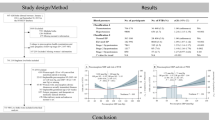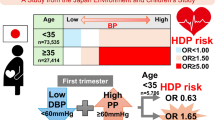Abstract
Associations between maternal age in pregnancy and offspring blood pressure (BP) at age 7½ were investigated in 7623 singletons from the Avon Longitudinal Study of Parents and Children (ALSPAC). In models adjusted for age and sex there was an inverse relationship between maternal age and BP in children: β=−0.06 mmHg per year of maternal age (95% CI −0.10 to −0.01, P=0.02) for systolic BP and β=−0.04 (95% CI −0.07 to −0.01, P=0.02) for diastolic BP. However, this association disappeared after adjustment for confounding factors: β=−0.02 mmHg per year of maternal age (95% CI −0.07 to 0.04, P=0.5) for systolic BP and β=−0.03 (95% CI −0.07 to 0.01, P=0.2) for diastolic BP. We conclude that there is no evidence of a relationship between maternal age in pregnancy and childhood BP in this contemporary birth cohort.
This is a preview of subscription content, access via your institution
Access options
Subscribe to this journal
Receive 12 digital issues and online access to articles
$119.00 per year
only $9.92 per issue
Buy this article
- Purchase on SpringerLink
- Instant access to full article PDF
Prices may be subject to local taxes which are calculated during checkout

Similar content being viewed by others
References
Stamler J, Stamler R, Neaton JD . Blood pressure, systolic and diastolic and cardiovascular risks. US population data. Arch Intern Med 1993; 153: 598–615.
De Swiet M, Fayers P, Shinebourne EA . Value of repeated BP measurements in children – Brompton Study. BMJ 1980; 280: 1567–1569.
Nelson MJ, Ragland DR, Syme SL . Longitudinal prediction of adult blood pressure from juvenile blood pressure levels. Am J Epidemiol 1992; 136: 633–645.
Enos MWF, Holmes LCRH, Beyer CJ . Coronary disease among United States soldiers killed in action in Korea. JAMA 1953; 152: 1090–1093.
McNamara MJJ, Molot MMA, Stremple MJF, Cutting RT . Coronary artery disease in combat casualties in Vietnam. JAMA 1971; 216: 1185–1187.
Newman WPI et al. Relation of serum lipoprotein levels and systolic blood pressure to early atherosclerosis. The Bogalusa Heart Study. N Engl J Med 1986; 314: 138–144.
Barker DJP . Fetal Origins of Adult Disease. BMJ Publishing Group: London, 1992.
Barker DJP . Mothers, Babies and Health in Later Life. Churchill Livingstone: London, 1998.
Huxley RR, Shiell AW, Law CM . The role of size at birth and postnatal catch-up growth in determining systolic blood pressure: a systematic review of the literature. J Hypertens 2000; 18: 815–831.
Hattersley AT, Tooke JE . The fetal insulin hypothesis: an alternative explanation of the association of low birth weight with diabetes and vascular disease. Lancet 1999; 353: 1789–1792.
Lucas A . Programming by early nutrition: an experimental approach. J Nutr 1998; 128: 401S–406S.
Singhal A, Lucas A . Early origins of cardiovascular disease: is there a unifying hypothesis? Lancet 2004; 363: 1642–1645.
Ruddock V, Wood R, Quinn M . Birth statistics. Recent trends in England and Wales. Population Trends 1998; 94: 12–18.
Weerasehera D, Udugama SG . Pregnancy at 40 and over: a case control study in a developing country. J Obstet Gynaecol 2003; 23(6): 625–627.
Dildy GA et al. Very advanced maternal age: pregnancy after age 45. Am J Obstet Gynecol 1996; 175: 668–674.
Viegas OA et al. Obstetric outcome with increasing maternal age. J Biosoc Sci 1994; 26(2): 261–267.
Dollberg S et al. Adverse perinatal outcome in older primipara. J Perinatol 1996; 16(2): 93–97.
Higgins M et al. Studies of blood pressure in Tecumseh, Michigan. I: Blood pressure in young people and its relationship to personal and familial characteristics and complications of pregnancy in mothers. Am J Epidemiol 1980; 111: 142–155.
Whincup PH, Cook DG, Shaper AG . Early influences on blood pressure: a study of children aged 5–7 years. BMJ 1989; 299: 587–591.
Lawlor DA et al. Associations of parental, birth and early life characteristics with systolic blood pressure at age 5: findings from the Mater-University study of pregnancy and its outcomes. Circulation 2004; 110(16): 2417–2423.
Gillman MW et al. Maternal age and other predictors of newborn blood pressure. J Pediatr 2004; 144(2): 240–245.
Golding J, Pembrey M, Jones R, the ALSPAC Study Team. ALSPAC-the Avon Longitudinal Study of Parents and Children. I. Study methodology. Paediatr Perinat Epidemiol 2001; 15: 4–87.
Office of Population Censuses and Surveys. Standard Occupational Classification. Her Majesty's Stationary Office: London, 1991.
Martin RM et al. Does breast-feeding in infancy lower blood pressure in childhood? The Avon Longitudinal Study of Parents and Children. Circulation 2004; 109: 1259–1266.
Acknowledgements
We are extremely grateful to all the women and children who took part in this study, the midwives for their help in recruiting them and the whole ALSPAC team, which includes interviewers, computer and laboratory technicians, clerical workers, research scientists, volunteers, managers, receptionists and nurses. ALSPAC is part of the World Health Organisation-initiated European Longitudinal Study of Parents and Children. ALSPAC is supported by the Medicial Research Council, the Wellcome Trust, the UK Department of Health, the Department of the Environment, the DfEE, the National Institutes of Health, and a variety of medical research charities and commercial companies. RJR wrote the first draft of the manuscript and assisted in data analysis. SDL extracted data from the main database, performed analysis and commented on drafts of the manuscript. AN and GDS helped plan analysis and commented on drafts of the manuscript. All authors saw and approved the final draft. None of the authors had any financial or personal interest in any company or organization sponsoring this research.
Author information
Authors and Affiliations
Consortia
Corresponding author
Rights and permissions
About this article
Cite this article
Roberts, R., Leary, S., Smith, G. et al. Maternal age in pregnancy and offspring blood pressure in childhood in the Avon Longitudinal Study of Parents and Children (ALSPAC). J Hum Hypertens 19, 893–900 (2005). https://doi.org/10.1038/sj.jhh.1001915
Received:
Revised:
Accepted:
Published:
Issue date:
DOI: https://doi.org/10.1038/sj.jhh.1001915
Keywords
This article is cited by
-
Effect of maternal smoking during pregnancy on child blood pressure in a European cohort
Scientific Reports (2022)
-
Sympathoadrenergic and metabolic factors and ambulatory blood pressure changes in childhood obesity
Journal of Human Hypertension (2008)



